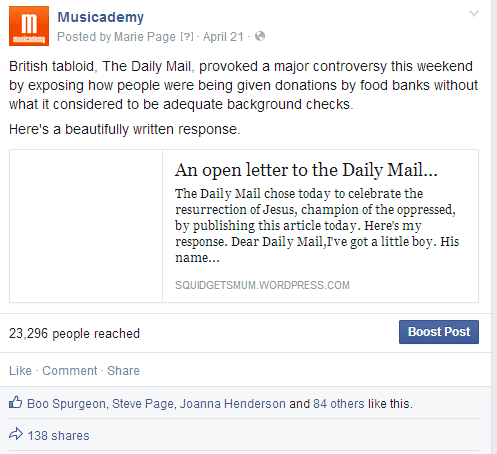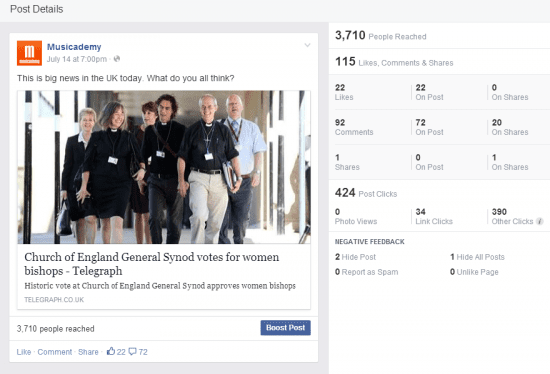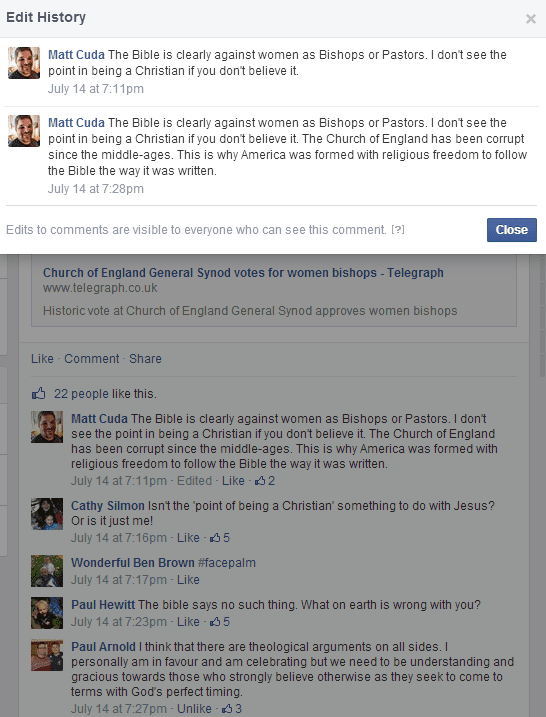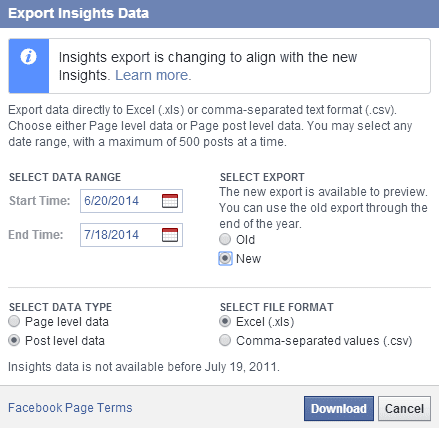Are Facebook Admins not paying enough attention to the data behind their Reach figures?
I've been digging down a little deeper into Facebook Insights of late trying to get a handle on the organic reach issue with the current incarnation of the algorithm. I had this theory that whilst a lot of Page Admins were breezily talking about how their reach had not been throttled in recent months and were still regularly reaching over 50% of fans, that in fact they were reading their data wrongly.
I've watched really popular posts of mine in recent months and a cursory look at the Insights data does indeed suggest that some posts are reaching an awful lot of people. Here's our top performing Facebook post of recent months (it used to drag an image through but I imagine the original link author has since removed it).

You can see that this achieved a reach of 23,296 people. Pretty impressive given that our fan numbers at the time were just 8,135. We appear to be reaching 286% of our fans!
Of course the reason for this huge reach is actually viral reach. This piece was shared 138 times. The organic reach (to our actual fan base) was in fact pretty standard. 2,328 of them were served the piece (only 28.62%).
This got me thinking about the new algorithm and I've been watching my data closely ever since. I've found it is almost impossible to achieve more than 35% reach of your fan base. But getting at this data takes a bit of digging and a little bit of maths. Here's another, more recent, example.
Does engagement alone result in high reach?
Last week the Church of England Synod finally voted for women bishops. Clearly a relevant piece of news for my audience (Christian musicians). So shortly after the announcement was made I found a reasonable news article on the topic and linked to it. You can see the post (and the top level Insights data) below:

Now I was well aware that for a proportion of our audience, this is actually a pretty controversial topic and sure enough it wasn't long before we received a pretty strong comment. I've screen clipped the comment so you get the gist of the story (you'll see in the first part that the user later edited what he'd said):

The post is here if you want to read further (welcome to my somewhat interesting and diverse community....)
As you can see from the greyed out area, this anti-women bishop comment inflamed a pretty passionate debate. I sat on the sidelines keeping an eye on the comments to check nothing got too out of order and watched what I assumed would be reach go stratospheric.
I was disappointed. Organic reach of fans hit just under 35% and viral reach was a meagre 9%. Why so poor when the article had attracted 22 Likes and 72 Comments? Well it hadn't attracted any Shares and Shares are pretty key to viral reach. People will share a Top Tips article or a well written piece of content but they are a lot less likely to be sharing a slanging match between opposing theological viewpoints (no real surprise there then!).
So to answer my question, engagement will result in Facebook sharing content to a reasonable proportion of a Page's fans - on this data alone likely a max of about 35%. But if you want higher reach than that the engagement needs to be very specific. It needs to include Shares to hit respectable viral levels. Sure friends of fans will often see stories of someone's interaction with a Page without Sharing but real virality only happens when the item is widely shared.
Facebook organic reach vs viral reach
If you are still with me let's take a look at a deeper dive into the data. First we need to look under the hood of the usual dashboard Insights so hit the Export button and choose to export Post level data:

You’ll then be served a big spreadsheet with lots of columns. I’ve hidden lots of these in the screen clip so that you can focus on what is important in terms of us understanding the organic vs the viral reach of this post and the complexity of the algorithm.

Firstly, note that there was no paid reach on any of these posts.
Secondly, let’s look at the post with the highest reach (it’s in blue). It’s got the best reach but that’s due in part to viral reach. Look how 2544 of the people that saw the post were not fans – this is the number of people who saw the post in a story from a friend (likely via the Share button). But what is reported in the top layer of Insights is the Total Reach number – 5528. So most Page admins will be simply making the assumption that they’ve got this organic reach business cracked – 65% reach. But as the calculations below show, organic reach of fan base was just under 34% and viral reach was responsible for over 30% of the impressions.
Facebook served this content to roughly the same number of fans but the fans were responsible for pushing the reach virally of the “blue” piece.
When we look at the yellow (women bishops) piece it had 22 Likes, 74 comments and no shares but the blue piece had 12 Likes, 3 comments and 20 shares.
Now viral reach is obviously great. You’re getting free additional coverage and it *may* result in new fans (I don’t generally find a big increase with these viral pieces though). But the point I’m making here is that the algorithm is complicated. This is reinforced by the content piece I’ve highlighted in pink. It enjoyed a far higher PTAT score than anything else yet it’s reach was far smaller. Why? Well it was a photo, and photos are not afforded good Edgerank at the moment – too many brands posting photos of cats and spammy memes are likely to blame. They get engagement but Facebook doesn’t like them so punishes all photos accordingly. I'm a little embarrassed about the photo really. Sure it's sort of relevant (it's a photo of a man in a guitar shaped boat) but it's silly season in the US at the moment where most of our fan base are so I figured a music and holiday themed photo would go down well.
The Yellow (article about in-ear monitors) piece was clearly incredibly engaging (more so than the blue women bishops piece) but as I've said, the women bishops debate wasn’t something people wanted to share. It was something controversial that they wanted to make a point about whereas the blue piece was an informational piece of content that they felt their friends would like to see.
So what is Facebook's likely max for organic reach of your fans?
Facebook appears to end up treating both pieces relatively equally. Both are clearly considered quality pieces of content but I think I’ve found the throttle limiter. I’ll stick my neck out on the basis of this and other similar experiments I’ve done. Facebook throttles organic fan reach at about 35%. If you’re seeing more than that it’s likely to be viral reach.
Can you do some similar calculations? What's the best reach you are finding of your fan base?
A little plug for me if you’d like some help with Facebook marketing
Along with a number of others I’ve recently set up a digital agency called The Digiterati. Facebook marketing (and training in Facebook) is one of the services we are offering. The 2-day Facebook and Power Editor training course includes a critical (and hopefully super helpful) look at your own Facebook activity. Please get in touch [email protected] if you’d like any more information.










